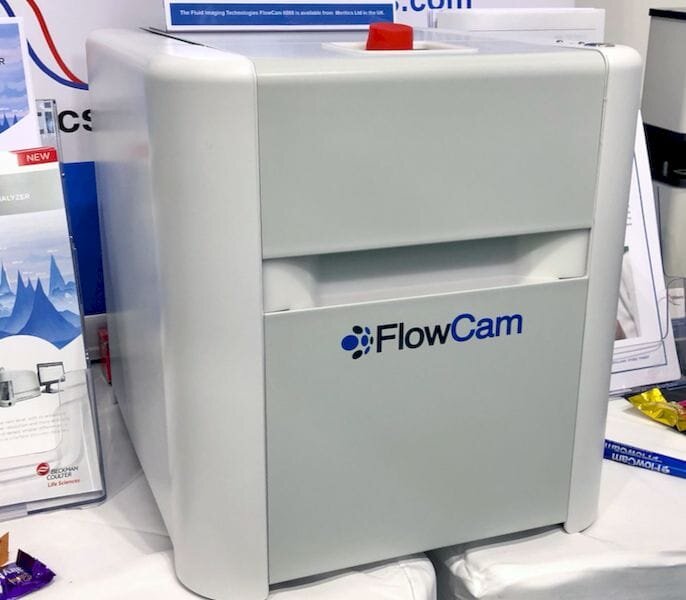![The FlowCam 8000 particle analyzer [Source: Fabbaloo]](https://fabbaloo.com/wp-content/uploads/2020/05/flowcam-8000-1_img_5eb08fbb681dd.jpg) The FlowCam 8000 particle analyzer [Source: Fabbaloo]
The FlowCam 8000 particle analyzer [Source: Fabbaloo]
I had an interesting chat with a representative from Meritics, a UK-based equipment reseller.
One of the items sold by this firm is a particle classifier, and I think this concept could have some interesting implications on any 3D print powder system, either metal or thermoplastic.
FlowCam Particle Analyzer
The item in question is the FlowCam Model 8000 by Fluid Imaging, a US-based firm producing particle analysis equipment. The device is able to sort input particles by a number of different parameters. Its basic sensors include a camera and a dimensional sensing capability.
The input powder flows into the Model 8000 and, literally, every single particle is analyzed.
The particles are matched against a “library” of sensor constraints that the operator can specify and save for future use. Eventually, an operator would generate a full catalog of sensing profiles for all the materials in question — and different scenarios for each.
Sorting Used Powder
The parameters essentially determine how the input stream is sorted, or “classified” in their terms. You end up with “good” and “bad” output streams.
For example, you might require all particles to be within a certain dimensional size. Those particles will end up in batch A, while all other particles would be in batch B from a given input stream.
That’s a very simplistic example. You could also sort on circularity, or rather how spherical each particle might be. This could ensure you don’t select for two fragments stuck together that just happen to be the correct dimension when joined.
![The FlowCam 8000 interior [Source: Fabbaloo]](https://fabbaloo.com/wp-content/uploads/2020/05/image-asset_img_5eb08fbbc3514.jpg) The FlowCam 8000 interior [Source: Fabbaloo]
The FlowCam 8000 interior [Source: Fabbaloo]
However, things get far more complex when the camera sensor is invoked. The camera allows analysis of any characteristic that’s visible. For example, you might measure the color of each particle, or perhaps the translucency of them. I think you get the idea; this is quite powerful.
Now let’s consider how powder is typically used in 3D printing.
Powder 3D Printing
Usually there is a flat bed of powder, where a laser or other power source applies energy to the surface selectively. When the print is finished, you have a full chamber block of powder with the finalized print buried inside. The print is removed and the remaining powder, which often is the majority of the powder, is considered “used”.
This powder can be recycled through the machine to avoid refilling with fresh powder, but there are limits. You must typically sieve the used powder to remove stray solidifications, because if they are used you will get “bumpy” results. This effect is common on laser systems, where “spatter” occurs, dropping extra bits all over.
Even after sieving, manufacturers usually recommend only a portion of a build’s powder be “used”, with ratios sometimes requiring, say, 50% fresh powder to be mixed in. This drastically limits the amount of recycling that can take place.
3D Print Powder Reclamation
Now, consider what might happen if we were to use one of these Fluid Imaging devices. It might be possible to shoot the used powder through it and perform a sort to ensure it is of higher quality than the typical pile of used powder. In other words, since there is little ability to deal with used powder normally, you could now pull out the really bad parts of the used powder directly.
I’m wondering if it might even be possible to sort the used powder so aggressively that the resulting powder is the same quality or even potentially better than the vendor’s fresh powder. Then you could absolutely use a higher percentage of used powder in subsequent prints, saving costs on fresh powder.
In theory this sounds good, but is it practical? According to my Meritics friend, the Model 8000 can process 1kg of nylon powder in only ten minutes! This means you could potentially process 12kg of used powder during a 2-hour 3D print job. This seems quite feasible for processing times.
Then there’s the cost. The Model 8000 is sold for £50,000 (US$62,000). That’s somewhat pricey, but not unreasonable if there is a lot of powder printing happening. Or, in the case of US$500 per kg of metal powder, that price represents only 124kg of metal powder. It seems that you could have a chance of breaking even or better with this approach.
Via Fluid Imaging and Meritics

